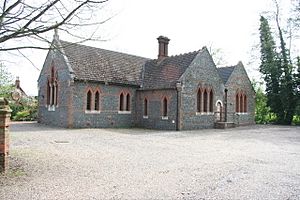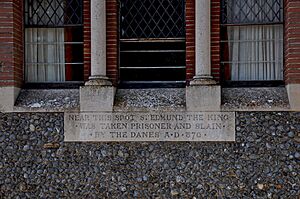Hoxne facts for kids
Quick facts for kids Hoxne |
|
|---|---|
 Village Hall, Hoxne |
|
| Population | 889 (2011) |
| District | |
| Shire county | |
| Region | |
| Country | England |
| Sovereign state | United Kingdom |
| Post town | EYE |
| Postcode district | IP21 |
| EU Parliament | East of England |
Hoxne (pronounced HOK-sən) is a village in the Mid Suffolk area of Suffolk, England. It's about 5 miles (8 km) east of Diss and half a mile south of the River Waveney. The village and its nearby areas, like Cross Street and Heckfield Green, are part of the Hoxne parish.
Hoxne is very important in geology. It gives its name to the Hoxnian Stage, which is a British part of the Pleistocene Ice Age. This period was a warmer time between two ice ages.
Contents
Discovering Ancient Tools
The area around Hoxne is super important for finding old things! People have found a huge Roman treasure here, very old stone tools, and it's the place that gave its name to the Hoxnian Stage of Earth's history.
In 1797, a man named John Frere made an amazing discovery. He found flint hand tools buried deep in the ground at the Hoxne Brick Pit. He was the first person to realize that these ancient tools were made by humans, not by nature. One of his handaxes is now in the British Museum in London.
Frere wrote a letter about his finds, saying these "weapons" were from a time "even beyond the present world." We now know this period was the Lower Paleolithic Age, which was a very, very long time ago. He noticed that these tools were found with bones of extinct elephants. This showed that early humans lived here at the same time as these huge animals.
The Hoxnian Stage
The tools were found in layers of earth from a time when a lake formed during a warm period in Europe. This warm period is now called the "Great Interglacial." Because of the evidence found at Hoxne, this entire warm period in Britain is called the "Hoxnian Stage."
Scientists studied pollen from plants and trees found in the undisturbed layers of soil at Frere's site. This helped them understand the cycles of warming and cooling that happened during this ancient time.
From 1971 to 1978, teams from the University of Chicago dug extensively at Frere's site. They confirmed that the handaxes were about 400,000 years old! This was around the same time as other important finds in Swanscombe, which also included human remains. Later research showed that these early humans, who were ancestors of the Neanderthals, lived here towards the end of this warm period. As the ice sheets returned, the lush valleys and forests disappeared, changing how these early people lived.
The Hoxne Brick Pit is a special place for science, but it has now been filled in.
The Amazing Hoxne Hoard
In 1992, something incredible was found in Hoxne: the Hoxne Hoard! This is the biggest collection of late Roman silver and gold ever found in Britain. It's also the largest collection of gold and silver coins from the 4th and 5th centuries found anywhere in the Roman Empire.
Just 14 years after the University of Chicago team finished their digs, a metal detectorist found the Hoard on the same farm, only a few hundred meters away. The Hoxne Hoard includes 14,865 Roman gold, silver, and bronze coins. It also has about 200 beautiful silver dishes and gold jewelry.
All these amazing objects are now kept at the British Museum in London. You can see the most important pieces there on display. In 1993, experts valued the hoard at £1.75 million, which would be even more money today!
The village also has a very old building called The Swan. It was built in 1480 by the Bishop of Norwich and was once known as Bishops' Lodge. Today, it's a popular pub.
The Legend of Saint Edmund
There's a local story about the death of Saint Edmund, who was the King of East Anglia. The legend says he was hiding from the Danish invaders under Goldbrook Bridge. A newly married couple saw his shiny gold spurs and told his enemies where he was. Because of this, Saint Edmund supposedly put a curse on all couples who cross that bridge on their way to get married!
The story continues that the Danes then killed him at St Edmund's Memorial, Hoxne because he refused to stop believing in Christianity.
The poet Jean Ingelow wrote a poem called 'The Tradition of the Golden Spurs' about this legend. She added a note explaining:
- Around the year 870, the Danes attacked East Anglia, which was ruled by King Edmund.
- After fighting bravely, Edmund was defeated in a battle near Hoxne. He hid under a bridge called Gold-bridge.
- His gold spurs shone in the moonlight, and a newly married couple saw them. The bride told his enemies where he was.
- The Danes offered Edmund his crown and life if he would give up his Christian faith. But he refused.
- When he was dragged onto the bridge, he put a curse (or warning) on anyone who would cross it on their way to get married. People in the area still believe this, and it's said that no bride or groom has crossed it to this day!



